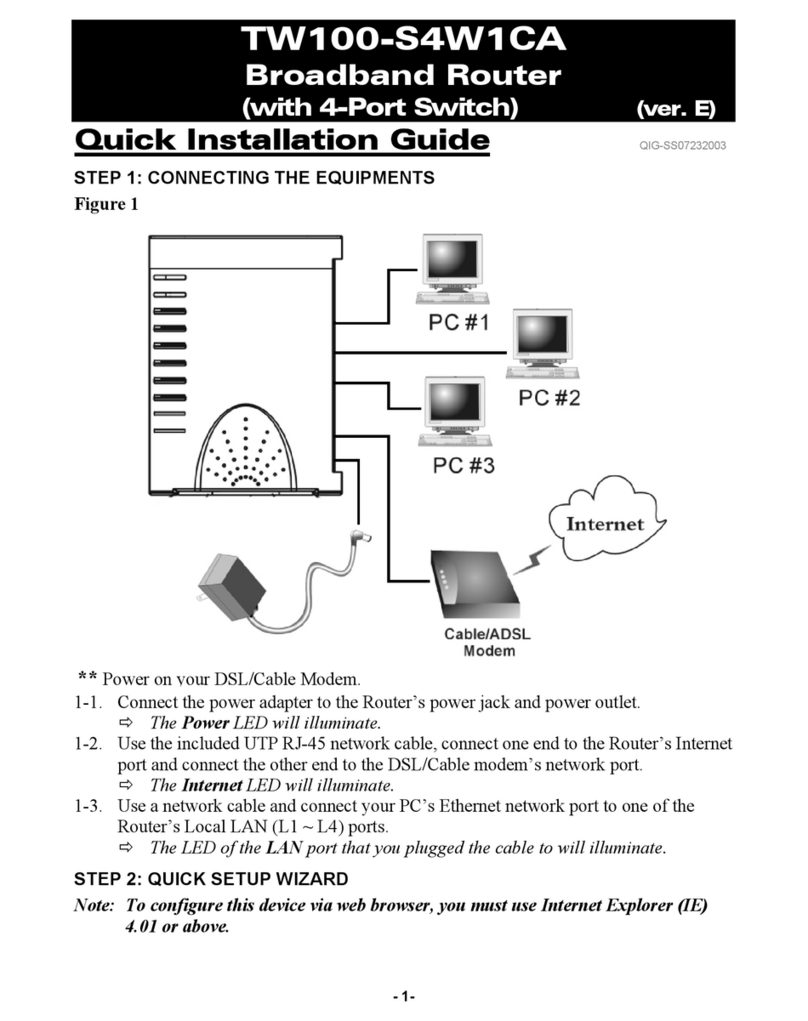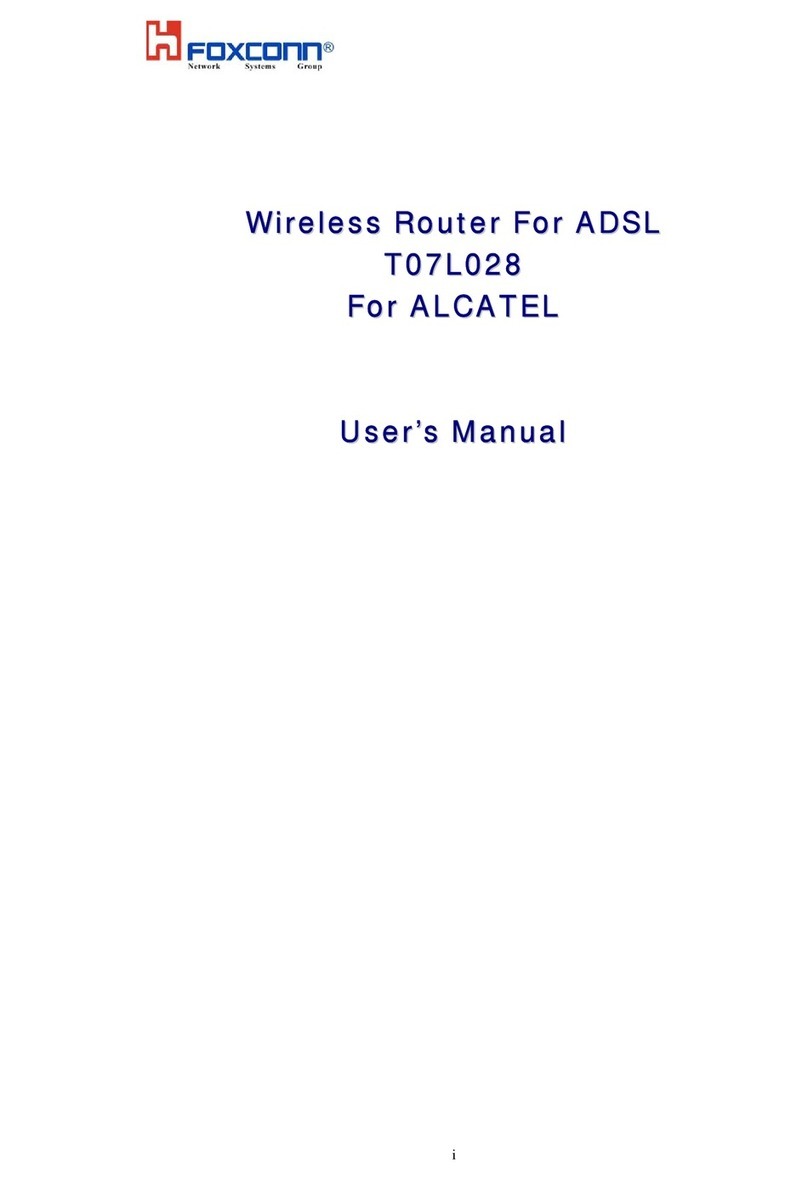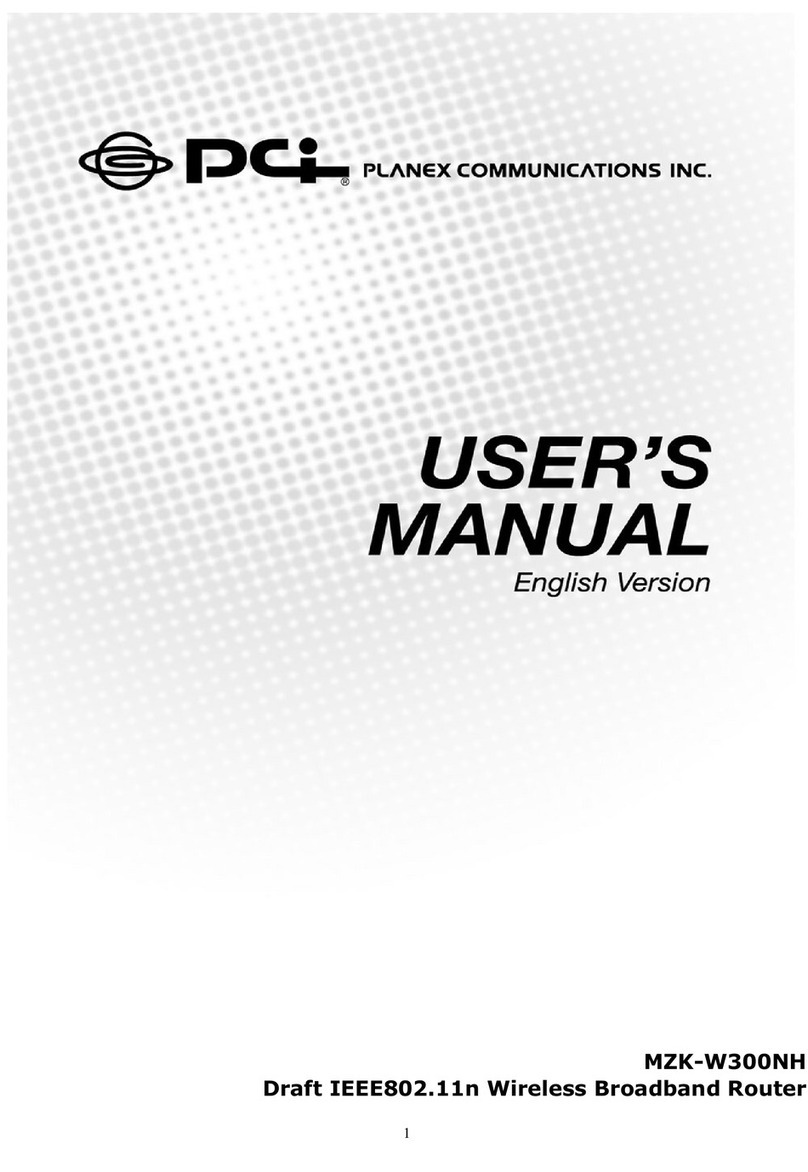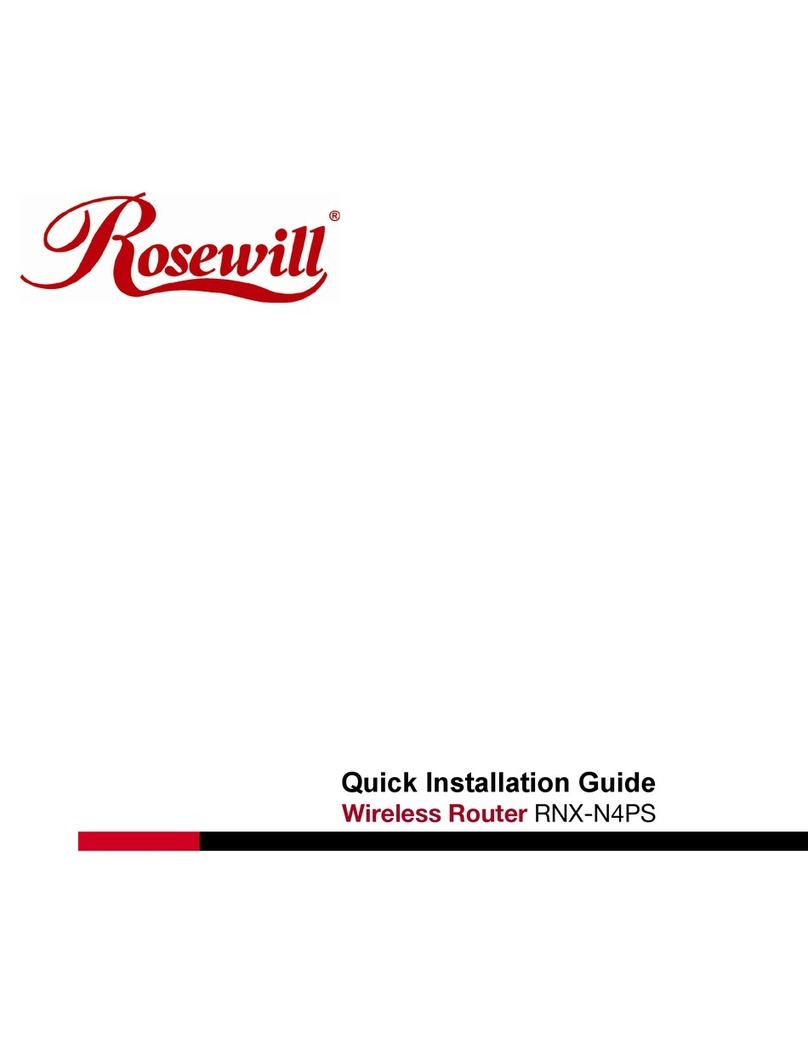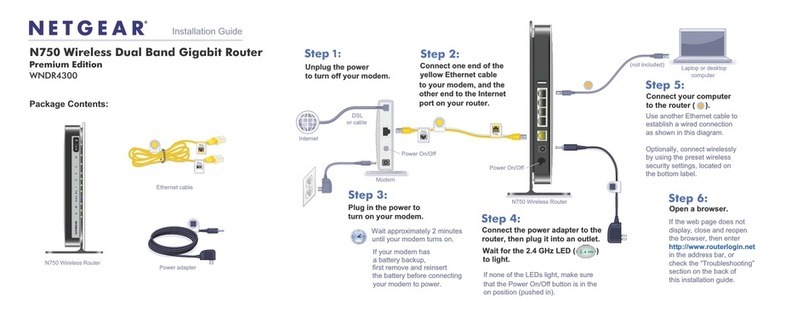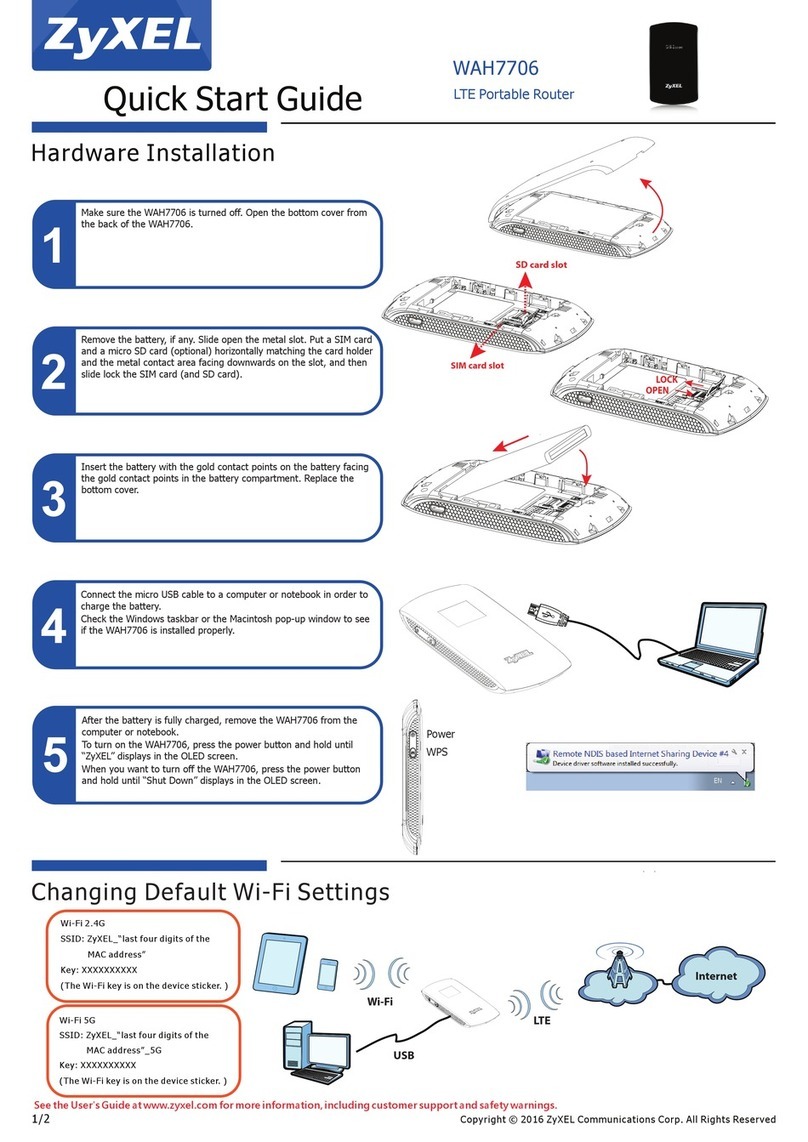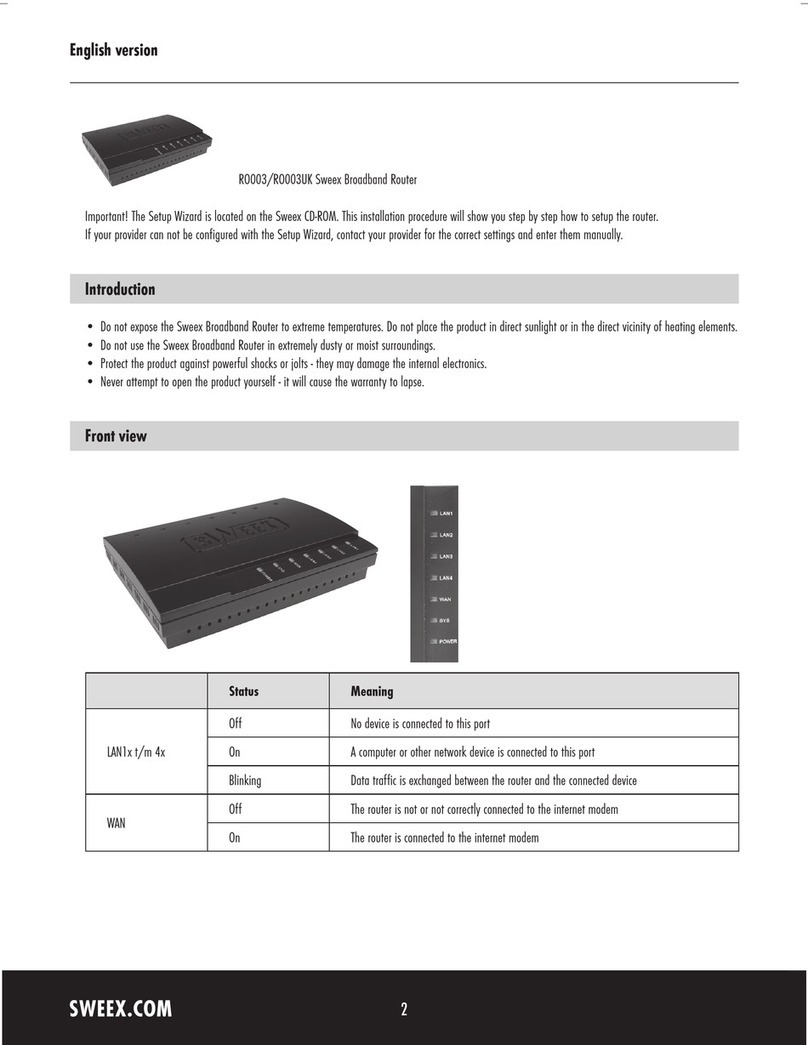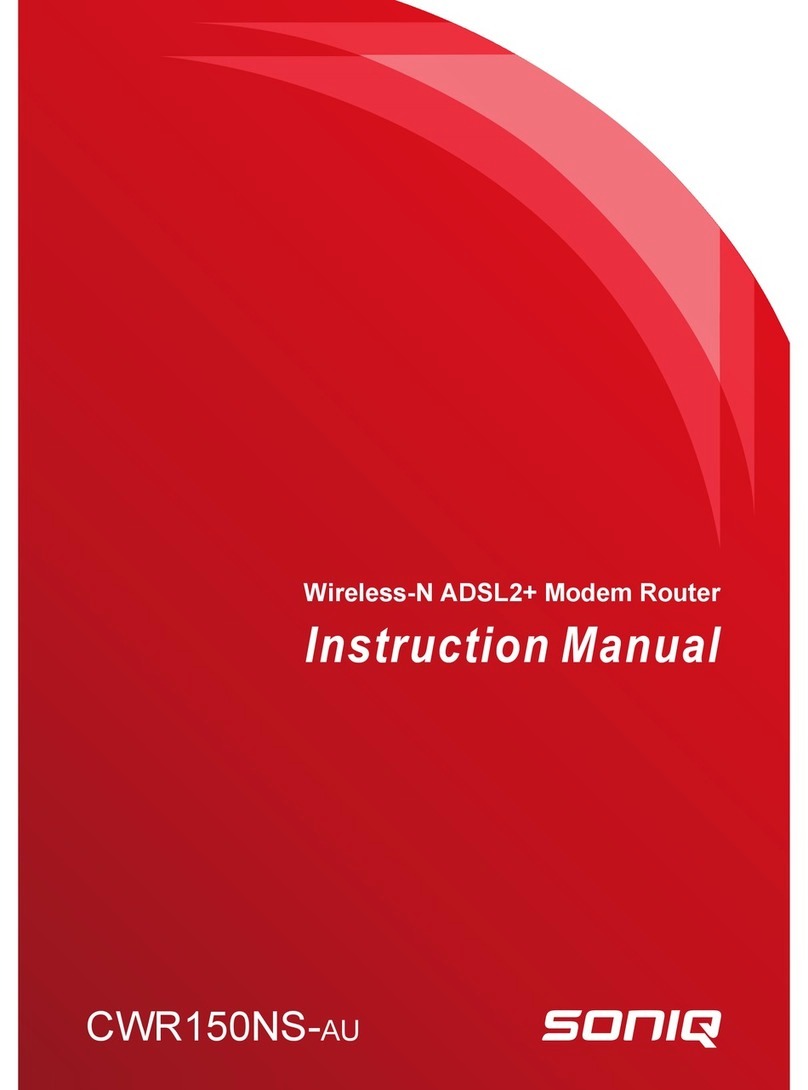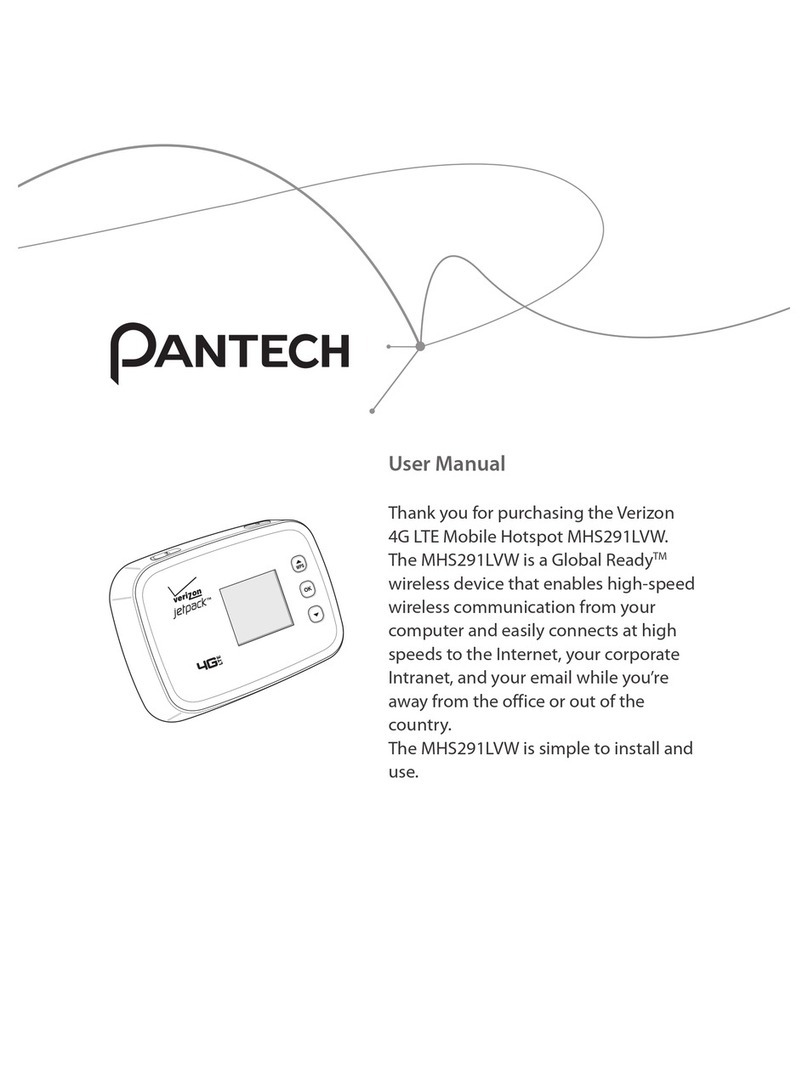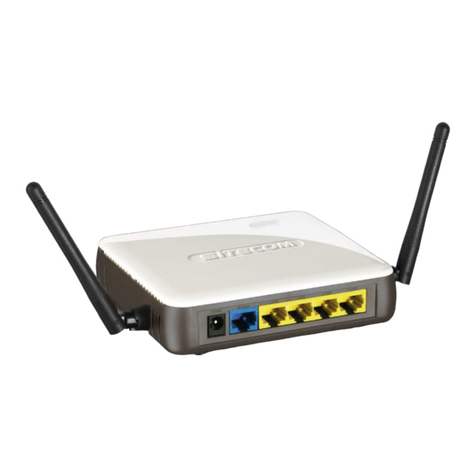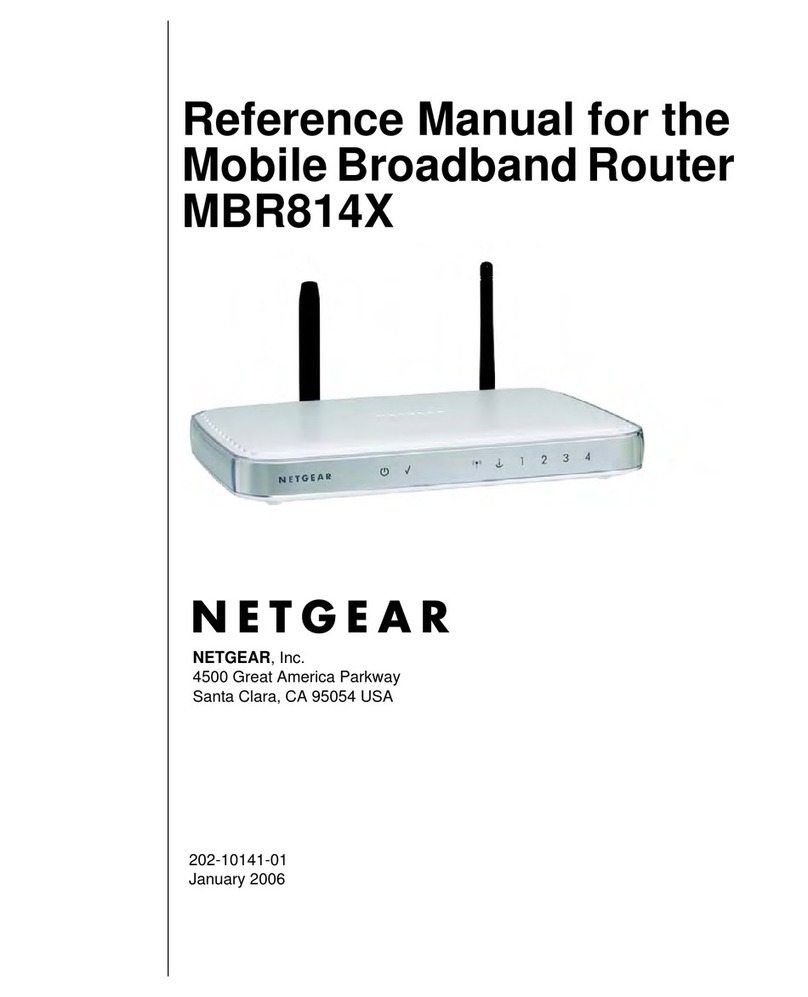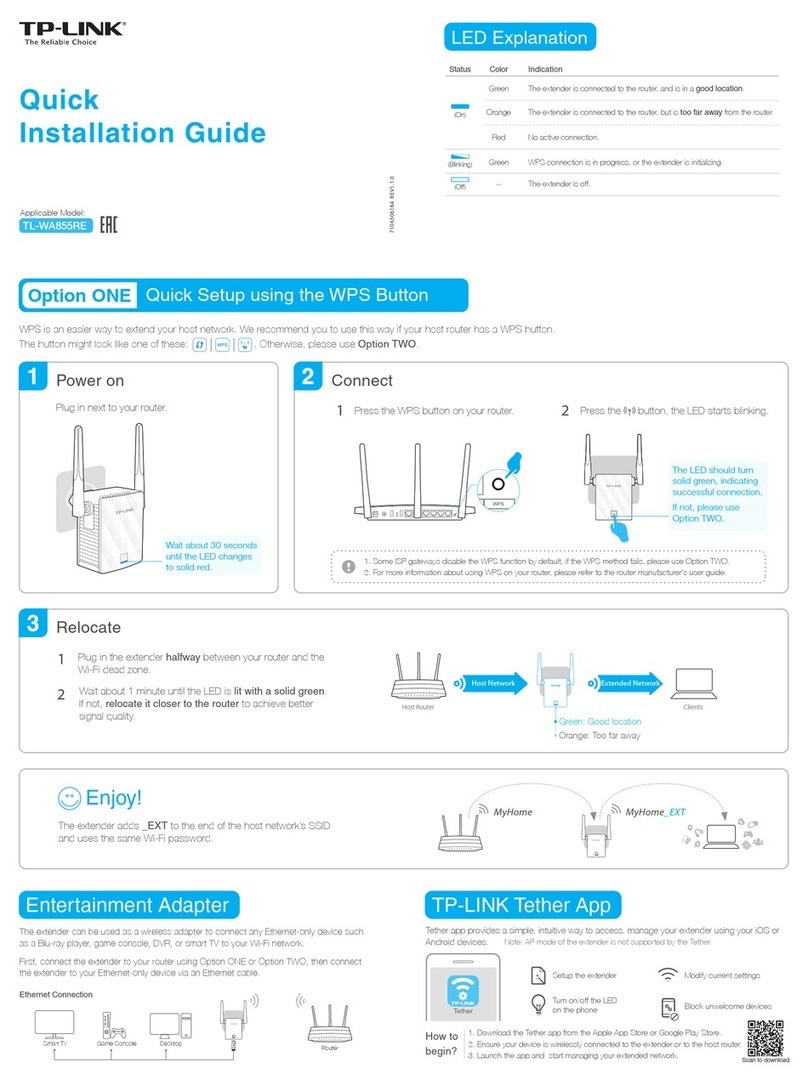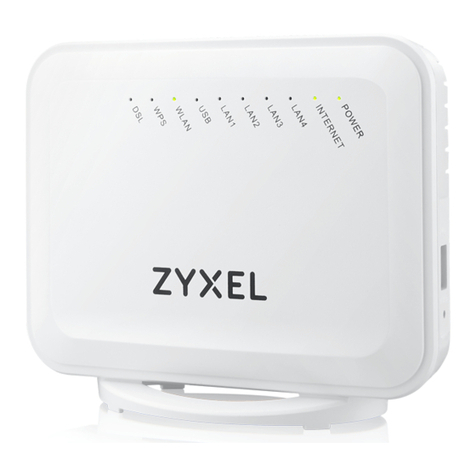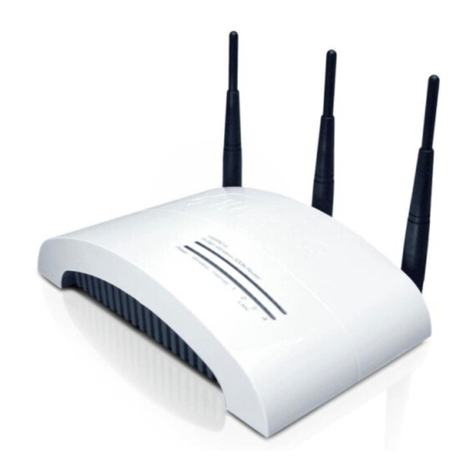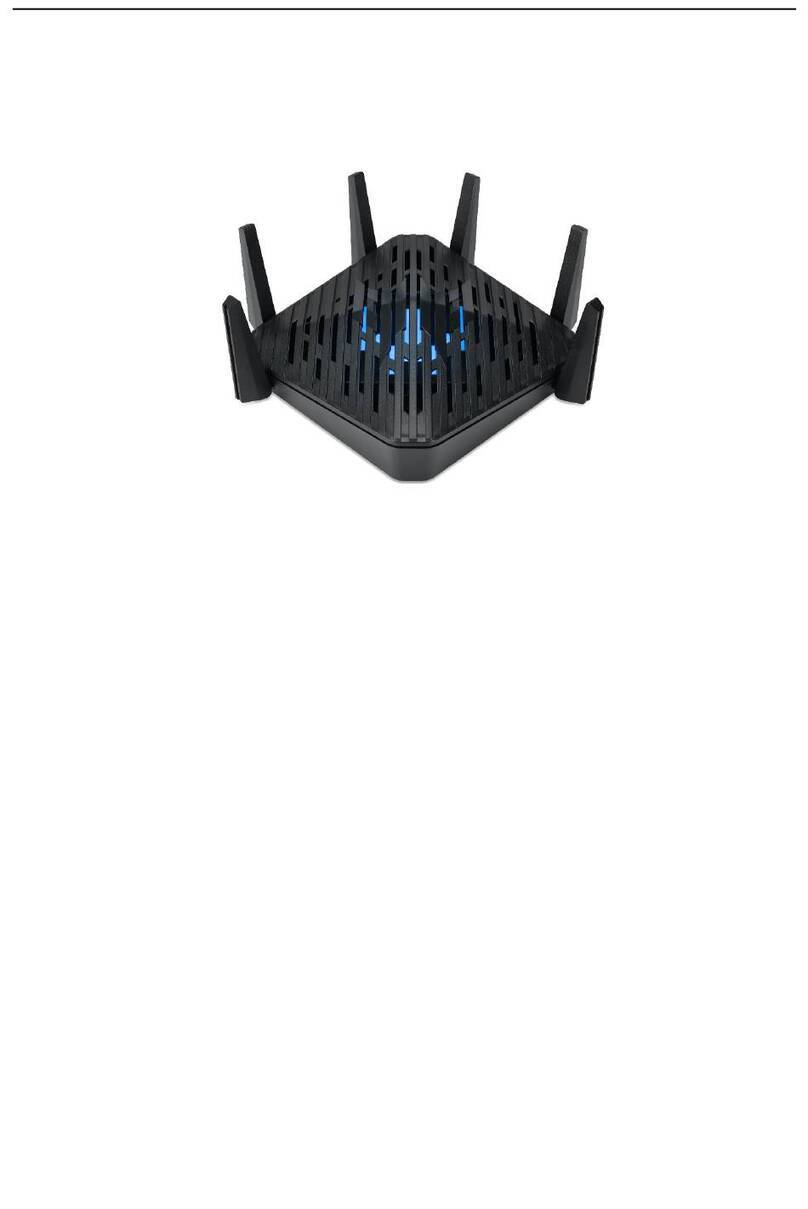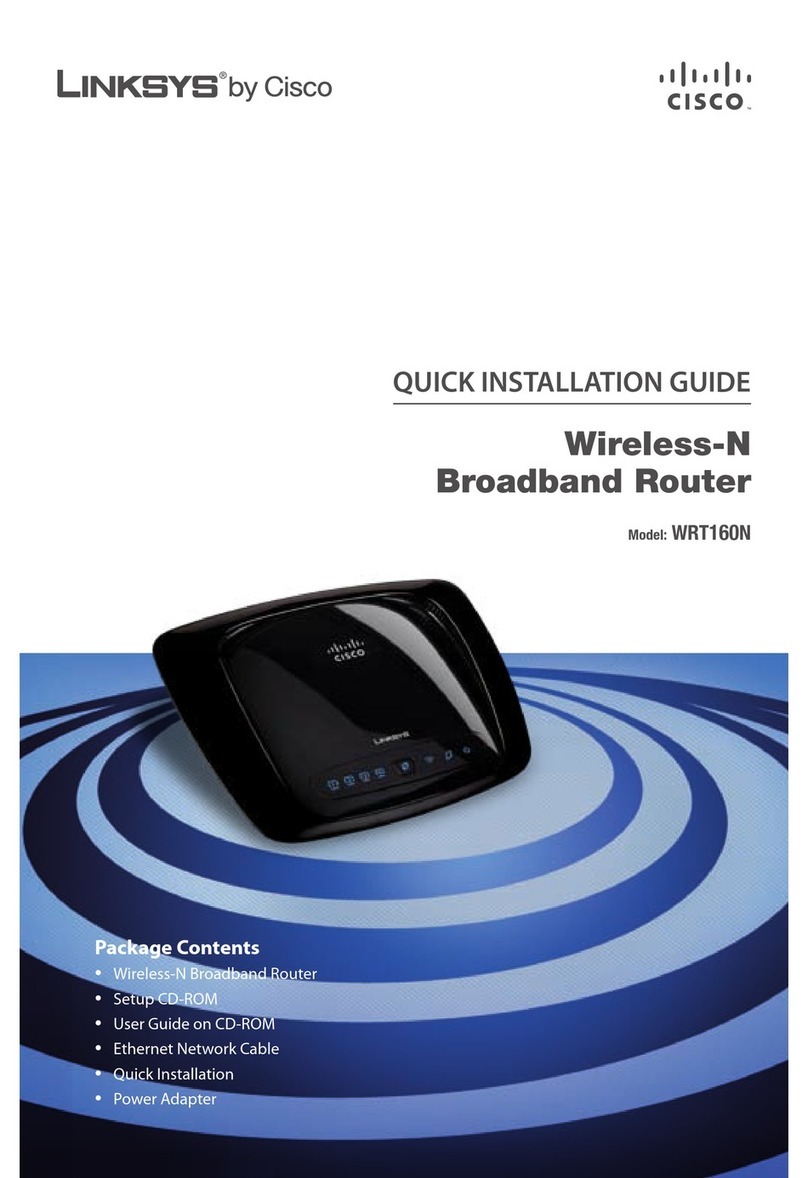TRENDware TEW-431BRP User manual

Exclusive Certification Corp. Tel:886-2-2792-3366 Fax:886-2-2792-1100 Issued date: Dec. 16, 2003 1 of 1
EMC Test Report: CE03111004-A
CE EMC TEST REPORT
according to
EN 301 489-1 V1.4.1 (2002-08) and
EN 301 489-17 V1.2.1 (2002-08)
Applicant TRENDware International, Inc.
Address 3135 Kashiwa Street, Torrance, CA90505 U.S.A.
Equipment Cable/DSL 802.11g 54Mbps Wireless Router
Model No. TEW-431BRP
Trade Name TRENDware
Power Supply Type AC Adaptor: Model: MW48-1201000U,
I/P: 230Vac/50Hz; O/P: 12Vdc, 800mA
The test result refers exclusively to the test presented test model / sample.
Without written approval of Exclusive Certification Corp. the test report shall not be reproduced
except in full.
This test report is only applicable to European Community.

Exclusive Certification Corp. Tel:886-2-2792-3366 Fax:886-2-2792-1100 Issued date: Dec. 16, 2003 2 of 2
EMC Test Report: CE03111004-A
Contents
CERTIFICATE OF COMPLIANCE .......................................................................................................................4
1. Definition......................................................................................................................................................5
2. Test Distance ...............................................................................................................................................6
2.1. Summary of Test Results ...........................................................................................................6
3. Test of Conducted Powerline.......................................................................................................................7
3.1. Test Procedures .........................................................................................................................7
3.2. Typical Test Setup Layout of Conducted Powerline...................................................................8
3.3. Conducted Emission Requirement ............................................................................................8
4. Test of Radiated Emission...........................................................................................................................9
4.1. Test Procedures .........................................................................................................................9
4.2. Typical Test Setup Layout of Radiated Emission.....................................................................10
4.3. Radiated Emission Requirement .............................................................................................10
5. Harmonics Test..........................................................................................................................................11
5.1. STANDARD..............................................................................................................................11
5.2. Test Procedure .........................................................................................................................11
6. Voltage Fluctuations Test...........................................................................................................................12
6.1. STANDARD..............................................................................................................................12
6.2. Test Procedure .........................................................................................................................12
7. Test setup (ESD) .......................................................................................................................................13
7.1. Test Setup for Tests Performed in Laboratory..........................................................................13
7.2. Test Procedure .........................................................................................................................14
8. Test Procedure (RS) ..................................................................................................................................15
9. Test on Power Line (EFT)..........................................................................................................................16
9.1. Test on Communication Lines..................................................................................................16
9.2. Test Procedure .........................................................................................................................16
10. Test Procedure (Surge).....................................................................................................................17
11. Test Procedure (CS) .........................................................................................................................18
12. Testing Requirement and Procedure (DIP).......................................................................................19
12.1. Test Conditions.........................................................................................................................19
12.2. Operating Condition .................................................................................................................19
13. Notice for Class A Product ................................................................................................................20
14. Declaration of Conformity and the CE Mark.....................................................................................20
15. Feature of Equipment under Test .....................................................................................................21
15.1. History of this test report ..........................................................................................................21
16. Test Configuration of Equipment under Test.....................................................................................22
16.1. Test Mode.................................................................................................................................22
16.2. Description of Test System.......................................................................................................22
17. Test Software ....................................................................................................................................23
18. General Information of Test ..............................................................................................................24
18.1. Description of Major Test Instruments......................................................................................25
19. Test Result of AC Powerline Conducted Emission ...........................................................................26
19.1. Test Mode 1 (CH 01b @ 11Mbps Bit-Rate)..............................................................................26
19.2. Photographs of Conducted Powerline Test Configuration .......................................................44
20. Test Result of Radiated Emission.....................................................................................................45
20.1. Test Mode 1 (TX / RX @ 11Mbps Bit – Rate) ..........................................................................45

Exclusive Certification Corp. Tel:886-2-2792-3366 Fax:886-2-2792-1100 Issued date: Dec. 16, 2003 3 of 3
EMC Test Report: CE03111004-A
20.2. Photographs of Radiated Emission Test Configuration ...........................................................47
21. Harmonics Test .................................................................................................................................48
22. Voltage Fluctuations Test..................................................................................................................49
22.1. TEST EQUIPMENT SETTINGS...............................................................................................49
22.2. Photographs of Harmonics test, Voltage Fluctuation and Flicker test .....................................50
23. Electrostatic Discharge Immunity Test (ESD) ...................................................................................51
23.1. Test Severity Levels .................................................................................................................51
23.2. Test Result of Air Discharge/ Contact Discharge .....................................................................52
23.3. Photographs of Electrostatic Discharge Immunity Test ...........................................................53
24. Radio Frequency Electromagnetic Field Immunity Test (RS)...........................................................55
24.1. Test Severity Levels .................................................................................................................55
24.2. Photographs of Radio Frequency Electromagnetic Field Immunity Test .................................56
25. Electrical Fast Transient/Burst Immunity Test (EFT/BURST) ...........................................................57
25.1. Test Severity Levels .................................................................................................................57
25.2. Photographs of Electrical Fast Transient/BURST Immunity Test.............................................58
26. Surge Immunity Test .........................................................................................................................59
26.1. TEST LEVEL............................................................................................................................59
26.2. Photographs of Surge Immunity Test.......................................................................................60
27. Conducted Disturbances Induced by Radio-Frequency Field Immunity Test (CS) ................61
27.1. TEST LEVEL............................................................................................................................61
27.2. OPERATING CONDITION .......................................................................................................61
27.3. Photographs of CS Tests .........................................................................................................62
28. Voltage Dips and Voltage Interruptions Immunity Tests....................................................................63
28.1. TEST LEVEL............................................................................................................................63
28.2. Photographs of Voltage Dips and Voltage Interruptions Immunity Tests .................................64
29. List of Measuring Equipment Used...................................................................................................65
Appendix A. Photographs of EUT……………………………………..…..………… ……….….……..A1 ~ A4

Exclusive Certification Corp. Tel:886-2-2792-3366 Fax:886-2-2792-1100 Issued date: Dec. 16, 2003 4 of 4
EMC Test Report: CE03111004-A
CERTIFICATE OF COMPLIANCE
according to
EN 301 489-1 V1.4.1 (2002-08) and
EN 301 489-17 V1.2.1 (2002-08)
Applicant TRENDware International, Inc.
Address 3135 Kashiwa Street, Torrance, CA90505 U.S.A.
Equipment Cable/DSL 802.11g 54Mbps Wireless Router
Model No. TEW-431BRP
I HEREBY CERTIFY THAT :
The measurements shown in this test report were made in accordance with the procedures
given in EUROPEAN COUNCIL DIRECTIVE 99/5/EC. The equipment was passed the
test performed according to EN 301 489-1 V1.4.1 (2002-08) and EN 301 489-17 V1.2.1
(2002-08). The test was carried out on Nov. 28, 2003 at Electronics Testing Center, Taiwan.

Exclusive Certification Corp. Tel:886-2-2792-3366 Fax:886-2-2792-1100 Issued date: Dec. 16, 2003 5 of 5
EMC Test Report: CE03111004-A
1. Definition
Unintentional radiator:
A device that intentionally generates and radio frequency energy for use within the device, or that sends
radio frequency signals by conduction to associated equipment via connecting wiring, but which is not
intended to emit RF energy by radiation or induction.
Class A Digital Device:
A digital device Which is marketed for use in commercial or business environment; exclusive of a device
which is market for use by the general public, or which is intended to be used in the home.
Class B Digital Device:
A digital device which is marketed for use in a residential environment notwithstanding use in a
commercial, business of industrial environment. Example of such devices that are marketed for the
general public.
Note:
A manufacturer may also qualify a device intended to be marketed in a commercial, business, or
industrial environment as a Class B digital device, and in fact is encouraged to do so, In the event that a
particular type of device has been found to repeatedly cause harmful interference to radio
communications, the Commission may classify such a digital device as a Class B Digital Device,
Regardless of its intended use.
Intentional radiator:
A device that intentionally generates and emits radio frequency energy by radiation or induction.

Exclusive Certification Corp. Tel:886-2-2792-3366 Fax:886-2-2792-1100 Issued date: Dec. 16, 2003 6 of 6
EMC Test Report: CE03111004-A
2. Test Distance
a. The test distance of radiated emission test from antenna to EUT is 10 M.
b. The test distance of radio frequency electromagnetic field immunity test from antenna to EUT is 3 M.
2.1. Summary of Test Results
19.1.1Emission Tests
Measurement Reference Clause(s) Test Reference standard
Radiated emission 8.2 PASSED EN 55022/A1:2000 class B
Conducted emission 8.3/8.4 PASSED EN 55022/A1:2000 class B
Harmonic current
emissions 8.5 N/A EN 61000-3-2:2000
Voltage fluctuations
and flicker 8.6 PASSED EN 61000-3-3:1995
19.1.2Immunity Tests
Measurement Reference Clause(s) Test Reference standard
Electrostatic
discharge 9.3 PASSED EN 61000-4-2:1995/A1:1998
RF electro-magnetic
Field (80-1000 MHz,
1400-2000 MHz.)
9.2 PASSED EN 61000-4-3:1996/A1:1998
Fast transients
common mode 9.4 PASSED EN 61000-4-4:1995
Surge 9.8
PASSED EN 61000-4-5:1995
Radio frequency,
common mode 9.5 PASSED EN 61000-4-6:1996
Voltage dips and
interrupts 9.7 PASSED EN 61000-4-11:1994

Exclusive Certification Corp. Tel:886-2-2792-3366 Fax:886-2-2792-1100 Issued date: Dec. 16, 2003 7 of 7
EMC Test Report: CE03111004-A
3. Test of Conducted Powerline
Conducted Emissions were measured from 150 kHz to 30 MHz with a bandwidth of 9 kHz and return leads
of the EUT according to the methods defined in European Standard EN 301 489-17. The EUT was placed
on a nonmetallic stand in a shielded room 0.8 meters above the ground plane as shown in section 2.2.
The interface cables and equipment positioning were varied within limits of reasonable applications to
determine the position producing maximum conducted emissions.
3.1. Test Procedures
a. The EUT was placed on a desk 0.8 meters height from the metal ground plane and 0.4 meter from
the conducting wall of the shielding room and it was kept at least 0.8 meters from any other
grounded conducting surface.
b. Connect EUT to the power mains through a line impedance stabilization network (LISN).
c. All the support units are connect to the other LISN.
d. The LISN provides 50 ohm coupling impedance for the measuring instrument.
e. The CISPR states that a 50 ohm , 50 microhenry LISN should be used.
f. Both sides of AC line were checked for maximum conducted interference.
g. The frequency range from 150 kHz to 30 MHz was searched
h. Set the test-receiver system to Peak Detect Function and Specified Bandwidth with Maximum Hold
Mode.

Exclusive Certification Corp. Tel:886-2-2792-3366 Fax:886-2-2792-1100 Issued date: Dec. 16, 2003 8 of 8
EMC Test Report: CE03111004-A
3.2. Typical Test Setup Layout of Conducted Powerline
3.3. Conducted Emission Requirement
The equipment under test EUT)shall meet the limits in table 1and 3 or 2 and 4,as applicable,
including the average limit and the quasi-peak limit when using,repectively, an average detector
receiver and quasi-peak detector receiver and measured in accordance with the methods
described in clause 9. Either the voltage limits or the current limits in table 3 or 4, as applicable,
shall be met except for the measurement method of C.1.3 where both limits shall be met. If the
average limit is met when using a qusai-peak decetor reciver, the EUT shall be deemeed to meet
both limits and measurement with the average detector receiver is unnecessary.
If the reading of the measuring receiver shows fluctuations close to the limit, the reading shall be
observed for at least 15 s at each measurement frequency, the higher reading shall be recorded
with the exception of any brief isolated hith reading which shall be ignored.
Limits (dB µ V)Frequency range
(MHz) Quasi Peak Average
0.15 to0.50 66 to 56* 56 to 46*
0.50 to5 56 46
5. to 30. 60 50
NOTE 1-The lower limits shall apply at the transition frequencies.
NOTE 2-The limit decreases linearly with the logarithm of the
frequency in the range 0.15 MHZ to 0.50MHZ.
10cm
80cm
EUT
80cm
40cm
LISN
80cm
40cm
LISN

Exclusive Certification Corp. Tel:886-2-2792-3366 Fax:886-2-2792-1100 Issued date: Dec. 16, 2003 9 of 9
EMC Test Report: CE03111004-A
4. Test of Radiated Emission
Radiated emissions from 30 MHz to 1000 MHz were measured with a bandwidth of 120 kHz according to
the methods defines in European Standard EN 301 489-17. The EUT was placed on a nonmetallic
stand in the open-field site, 0.8 meter above the ground plane, as shown in section 3.2. The interface
cables and equipment positions were varied within limits of reasonable applications to determine the
positions producing maximum radiated emissions.
4.1. Test Procedures
a. The EUT was placed on a rotatable table top 0.8 meter above ground.
b. The EUT was set 10 meters from the interference receiving antenna which was mounted on
the top of a variable height antenna tower.
c. The table was rotated 360 degrees to determine the position of the highest radiation.
d. The antenna is a half wave dipole and its height is varied between one meter and four meters
above ground to find the maximum value of the field strength both horizontal polarization and
vertical polarization of the antenna are set to make the measurement.
e. For each suspected emission the EUT was arranged to its worst case and then tune the
antenna tower (from 1 M to 4 M) and turn table (from 0 degree to 360 degrees) to find the
maximum reading.
f. Set the test-receiver system to Peak Detect Function and specified bandwidth with Maximum
Hold Mode.
g. If the emission level of the EUT in peak mode was 3 dB lower than the limit specified, then
testing will be stopped and peak values of EUT will be reported, otherwise, the emissions
which do not have 3 dB margin will be repeated one by one using the quasi-peak method and
reported.

Exclusive Certification Corp. Tel:886-2-2792-3366 Fax:886-2-2792-1100 Issued date: Dec. 16, 2003 10 of 10
EMC Test Report: CE03111004-A
4.2. Typical Test Setup Layout of Radiated Emission
4.3. Radiated Emission Requirement
The EUT shall meet limits of tables as below when measured at the measuring distance R in
accordance with the methods described in clause 10. If the reading on the measuring receiver
shows fluctuations close to the limit, the reading shall be observed for at least 15 s at each isolated
high reading, which shall be ignored.
Limit for radiated disturbance of class B ITE at a measuring distance of 10 m
Frequency
(MHz)
Quasi-peak limits
dB (uV/m)
30 to 230 30
230 to 1000 37
Note 1- The lower limit shall apply at the transition frequency.
2- Additional provisions may be required for cases where interference
occurs.
Turn Table 0.8M
Equipment under Test
Ground Plane
Receiver
* Test distance
Antenna

Exclusive Certification Corp. Tel:886-2-2792-3366 Fax:886-2-2792-1100 Issued date: Dec. 16, 2003 11 of 11
EMC Test Report: CE03111004-A
5. Harmonics Test
5.1. STANDARD
zProduct Standard : EN 61000-3-2:2000
5.2. Test Procedure
As specified on clause 7 and figure Z1 of EN 61000-3-2:2000, the limits are not specified for
equipment with a rated power of 75W or less.
The EUT meets the above condition, so it conforms to EN 61000-3-2.

Exclusive Certification Corp. Tel:886-2-2792-3366 Fax:886-2-2792-1100 Issued date: Dec. 16, 2003 12 of 12
EMC Test Report: CE03111004-A
6. Voltage Fluctuations Test
6.1. STANDARD
zProduct Standard : EN 61000-3-3:1995/A1:2001
6.2. Test Procedure
The equipment shall be tested under the conditions of Clause 5.
The total impedance of the test circuit, excluding the appliance under test, but including the internal
impedance of the supply source, shall be equal to the reference impedance. The stability and
tolerance of the reference impedance shall be adequate to ensure that the overall accuracy of ±8%
is achieved during the whole assessment procedure.

Exclusive Certification Corp. Tel:886-2-2792-3366 Fax:886-2-2792-1100 Issued date: Dec. 16, 2003 13 of 13
EMC Test Report: CE03111004-A
7. Test setup (ESD)
HCP
TABLE SIZE
1.6LX0.8WX0.5H m
VCP: 0.5x0.5 m
470K ohm
GRP
470K ohm
470K ohm
470K ohm
10cm
10cm
EUT
1.6mx0.8m
The test setup consists of the test generator, EUT and auxiliary instrumentation necessary to
perform DIRECT and INDIRECT application of discharges to the EUT as applicable, in the follow
manner :
a. CONTACT DISCHARGE to the conductive surfaces and to coupling plane;
b. AIR DISCHARGE at insulating surfaces.
The preferred test method is that of type tests performed in laboratories and the only accepted
method of demonstrating conformance with this standard. The EUT was arranged as closely as
possible to arrangement in final installed conditions.
7.1. Test Setup for Tests Performed in Laboratory
A ground reference plane was provided on the floor of the test site. It was a metallic sheet (copper or
aluminum) of 0.25 mm, minimum thickness; other metallic may be used but they shall have at least 0.65
mm thickness. In the ELECTRONICS TESTING CENTER., we provided 1 mm thickness aluminum
ground reference plane or 1 mm thickness stainless steel ground reference plane. The minimum size of
the ground reference plane is 1 m x 1 m, the exact size depending on the dimensions of the EUT. It was
connected to the protective grounding system.
The EUT was arranged and connected according to its functional requirements. A distance of 1m
minimum was provided between the EUT and the wall of the lab. and any other metallic structure. In
cases where this length exceeds the length necessary to apply the discharges to the selected points, the
excess length shall, where possible, be placed non-inductively off the ground reference plane and shall
not come closer than 0.2m to other conductive parts in the test setup.
Where the EUT is installed on a metal table, the table was connected to the reference plane via a cable
with a 470k ohm resister located at each end, to prevent a build-up of charge. The test setup was
consist a wooden table, 0.8m high, standing on the ground reference plane. A HCP, 1.6 m x 0.8 m, was
placed on the table. The EUT and cables was isolated from the HCP by an insulating support 0.5 mm
thick. The VCP size, 0.5 m x 0.5 m.

Exclusive Certification Corp. Tel:886-2-2792-3366 Fax:886-2-2792-1100 Issued date: Dec. 16, 2003 14 of 14
EMC Test Report: CE03111004-A
7.2. Test Procedure
a. In the case of air discharge testing the climatic conditions shall be within the following ranges:
- ambient temperature: 15 to 35 ;℃℃
- relative humidity : 30%to 60%;
- atmospheric pressure : 68 KPa (680 mbar) to 106 KPa (1060 mbar).
b. Test programs and software shall be chosen so as to exercise all normal modes of operation of the
EUT. The use of special exercising software is encouraged, but permitted only where it can be
shown that the EUT is being comprehensively exercised.
c. The test voltage shall be increased from the minimum to the selected test severity level, in order to
determine any threshold of failure. The final severity level should not exceed the product
specification value in order to avoid damage to the equipment.
d. The test shall be performed with both air discharge and contact discharge. On preselected points at
least 10 single discharges (in the most sensitive polarity) shall be applied on air discharge. On
preselected points at least 25 single discharges (in the most sensitive polarity) shall be applied on
contact discharge.
e. For the time interval between successive single discharges an initial value of one second is
recommended. Longer intervals may be necessary to determine whether a system failure has
occurred.
f. In the case of contact discharges, the tip of the discharge electrode shall touch the EUT before the
discharge switch is operated.
g. In the case of painted surface covering a conducting substrate, the following procedure shall be
adopted :
If the coating is not declared to be an insulating coating by the equipment manufacturer, then the
pointed tip of the generator shall penetrate the coating so as to make contact with the
conducting substrate.
Coating declared as insulating by the manufacturer shall only be submitted to the air discharge.
The contact discharge test shall not be applied to such surfaces.
h. In the case of air discharges, the round discharge tip of the discharge electrode shall be approached
as fast as possible (without causing mechanical damage) to touch the EUT . After each discharge, the
ESD generator (discharge electrode) shall be removed from the EUT. The generator is then
retriggered for a new single discharge. This procedure shall be repeated until the discharges are
completed. In the case of an air discharge test, the discharge switch, which is used for contact
discharge, shall be closed.

Exclusive Certification Corp. Tel:886-2-2792-3366 Fax:886-2-2792-1100 Issued date: Dec. 16, 2003 15 of 15
EMC Test Report: CE03111004-A
8. Test Procedure (RS)
a. The equipment to be tested is placed in the center of the enclosure on a wooden table. The
equipment is then connected to power and signal leads according to pertinent installation instructions.
b. The antenna which is enabling the complete frequency range of 80-1000MHz; 1400-2000 MHz is
placed 3m away from the equipment. The required field strength is determined by placing the field
strength meter(s) on top of or directly alongside the equipment under test and monitoring the field
strength meter via a remote field strength indicator outside the enclosure while adjusting the
continuous-wave to the applicable antennae.
c. The test is normally performed with the antenna facing the most sensitive side of the EUT. The
polarization of the field generated by the biconical antenna necessitates testing each position twice,
once with the antenna positioned vertically and again with the antenna positioned horizontally. The
circular polarization of the field from the log-spiral antenna makes a change of position of the antenna
unnecessary.
d. At each of the above conditions, the frequency range is swept 80-1000 MHz; 1400-2000 MHz,
pausing to adjust the R.F. signal level or to switch oscillators and antenna. The rate of sweep is in the
order of 1.5*10-3 decades/s. The sensitive frequencies or frequencies of dominant interest may be
discretely analyzed.

Exclusive Certification Corp. Tel:886-2-2792-3366 Fax:886-2-2792-1100 Issued date: Dec. 16, 2003 16 of 16
EMC Test Report: CE03111004-A
9. Test on Power Line (EFT)
a. The EFT/B-generator was located on the GRP.. The length from the EFT/B-generator to the EUT as
not exceed 1 m.
b. The EFT/B-generator provides the ability to apply the test voltage in a non-symmetrical condition to
the power supply input terminals of the EUT..
9.1. Test on Communication Lines
a. The coupling clamp is composed of a clamp unit for housing the cable (length more than 3 m), and
was placed on the GRP.
b. The coupling clamp provides the ability of coupling the fast transient/bursts to the cable under test.
9.2. Test Procedure
a. In order to minimize the effect of environmental parameters on test results, the climatic
conditions when test is carrying out shall comply with the following requirements:
ambient temperature: 15 to 35 ;℃℃
relative humidity : 45%to 75%;
atmospheric pressure : 68 Kpa (680 mbar) to 106 Kpa (1060 mbar).
b. In order to minimize the effect of environmental parameters on test results, the electromagnetic
environment of the laboratory shall not influence the test results.
c. The variety and diversity of equipment and systems to be tested make it difficult to establish
general criteria for the evaluation of the effects of fast transients/bursts on equipment and
systems.
d. The test results may be classified on the basic of the operating conditions and the functional
specification of the equipment under test, according to the following performance criteria :
Normal performance within the specification limits.
Temporary degradation or loss of function or performance which is self-recoverable.
Temporary degradation or loss of function or performance which requires operator
intervention or system reset.
Degradation or loss of function which is not recoverable due to damage of equipment
(components).

Exclusive Certification Corp. Tel:886-2-2792-3366 Fax:886-2-2792-1100 Issued date: Dec. 16, 2003 17 of 17
EMC Test Report: CE03111004-A
10. Test Procedure (Surge)
a. Climatic conditions
The climatic conditions shall comply with the following requirements :
ambient temperature : 15 to 35℃℃
relative humidity : 10 % to 75 %
atmospheric pressure : 86 kPa to 106 kPa ( 860 mbar to 1060 mbar )
b. Electromagnetic conditions
the electromagnetic environment of the laboratory shall not influence the test results.
c. The test shall be performed according the test plan that shall specify the test set-up with
generator and other equipment utilized;
test level ( voltage/current );
generator source impedance;
internal or external generator trigger;
number of tests : at least five positive and five negative at the selected points;
repetition rate : maximum 1/min.
inputs and outputs to be tested;
representative operating conditions of the EUT;
sequence of application of the surge to the circuit;
phase angle in the case of a.c. power supply;
actual installation conditions, for example :
AC : neutral earthed,
DC : ( + ) or ( - ) earthed to simulated the actual earthing conditions.
d. If not otherwise specified the surges have to be applied synchronized to the voltage phase at the
zero-crossing and the peak value of the a.c. voltage wave ( positive and negative ).
e. The surges have to be applied line to line and line(s) and earth. When testing line to earth, the
test voltage has to be applied successively between each of the lines and earth, if there is no other
specification.
f. The test procedure shall also consider the non-linear current-voltage characteristics of the
equipment under test. Therefore the test voltage has to be increased by steps up to the test level
specified in the product standard or test plan.
g. All lower levels including the selected test level shall be satisfied. For testing the secondary
protection, the output voltage of the generator shall be increased up to the worstcase voltage
breakdown level ( let-through level ) of the primary protection.
h. If the actual operating signal sources are not available, the may be simulated. Under no
circumstances may the test level exceed the product specification. The test shall be carried out
according the a test plan.
i. To find all critical points of the duty cycle of the equipment, a sufficient number of positive and
negative test pulses shall be applied. For acceptance test a previously unstressed equipment
shall be used to the protection devices shall be replaced.

Exclusive Certification Corp. Tel:886-2-2792-3366 Fax:886-2-2792-1100 Issued date: Dec. 16, 2003 18 of 18
EMC Test Report: CE03111004-A
11. Test Procedure (CS)
a. The EUT shall be operated within its intended climatic conditions. The temperature and relative
humidity should be recorded.
b. This test method test can be performed without using a sell shielded enclosure. This is because
the disturbance levels applied and the geometry of the setups are not likely to radiated a high
amount of energy, especially at the lower frequencies. If under certain circumstances the radiated
energy is too high, a shielded enclosure has to be used.
c. The test shall be performed with the test generator connected to each of the coupling and
decoupling devices in turn while the other non-excited RF-input ports of the coupling devices are
terminated by a 50 ohm load resistor.
d. The frequency range is swept from 150 KHz to 230 MHz, using the signal levels established during
the setting process, and with the disturbance signal 80% amplitude modulated with a 1KHz
sinewave, pausing to adjust the RF-signal level or to switch coupling devices as necessary. The
rate of sweep shall no exceed 1.5 x 10-3 decades/s. Where the frequency is swept incrementally,
the step size shall no exceed 1% of the start and thereafter 1% of the preceding frequency value.
e. The dwell time at each frequency shall not be less than the time necessary for the EUT to be
exercised, and able to respond. Sensitive frequencies e.g. clock frequency(ies) and harmonics or
frequencies of dominant interest shall be analyzed separately.
f. An alternative test procedure may be adopted, wherein the frequency range is swept incrementally,
with a step size not exceeding 4% of the start ad thereafter 4% of the preceding frequency value.
The test level should be at least twice the value of the specified test level.
g. In cases of dispute, the test procedure using a step size not exceeding 1% of the start and
thereafter 1% of preceding frequency value shall take precedence.
h. Attempts should be made to fully exercise the EUT during testing, and to fully interrogate all
exercise modes selected for susceptibility.
i. The use of special exercising programs is recommended.
j. Testing shall be performed according to a Test Plan, which shall be included in the test report.
k. It may be necessary to carry out some investigatory testing in order to establish some aspects of
the test plan.

Exclusive Certification Corp. Tel:886-2-2792-3366 Fax:886-2-2792-1100 Issued date: Dec. 16, 2003 19 of 19
EMC Test Report: CE03111004-A
12. Testing Requirement and Procedure (DIP)
The test was based on IEC 61000-4-11 (1994)
12.1. Test Conditions
1. Source voltage and frequency : 230V / 50Hz, Single phase.
2. Test of interval : 10 sec.
3. Level and duration : Sequency of 3 dips/interrupts.
4. Voltage rise (and fall) time : 1 ∼5 µs.
5.Testseverity:
Voltage dip and
Interrupt reduction (%)
Test Duration
(ms)
30 500
60 100
100 10
100 80
100 5000
12.2. Operating Condition
Full system

Exclusive Certification Corp. Tel:886-2-2792-3366 Fax:886-2-2792-1100 Issued date: Dec. 16, 2003 20 of 20
EMC Test Report: CE03111004-A
13. Notice for Class A Product
This Notice is for class A product only. If the Equipment under Test is a class B product,
this notice should be disregarded.
Class A ITE is a category of all other ITE which satisfies the class A ITE limits but not the class B
ITE limits. Such equipment should not be restricted in its sale but the following warning shall be
included in the instructions for use:
Warning
This is a class A product. In a domestic environment this product may cause radio interference in
which case the user may be required to take adequate measures.
14. Declaration of Conformity and the CE Mark
There are three possible procedures pertaining to the declaration of conformity:
14.1. Conformity Testing and Declaration of Conformity by the Manufacturer or His
Authorized Representative Established within the Community or by an Importer.
- Article 10 (1) of the EMC Directive, - §3 (1) no. 2a of the EMC Act.
14.2. Declaration of Conformity Issued by the Manufacturer or His Authorized
Representative Established within the Community or by an Importer Following
Testing of the Product and Issued of an EC certificate of conformity by a
competent body.
- Article 10 (2) of the EMC Directive, - §3 (1) no. 2b of the EMC Act.
14.3. Declaration of Conformity Issued by the Manufacturer or His Authorized
Representative Established within the Community or by an Importer Following
Testing and Certification of the Product by a Notified Body.
- Article 10 (5) of the EMC Directive,
- §3 (1) no. 2b of the EMC Act (radio transmitting installations).
14.4. Specimen For The CE Marking Of Electrical / Electronical Equipment
The components of the CE marking shall have substantially the same vertical dimension, which
may not be less than 5 mm.
Table of contents
Other TRENDware Wireless Router manuals
